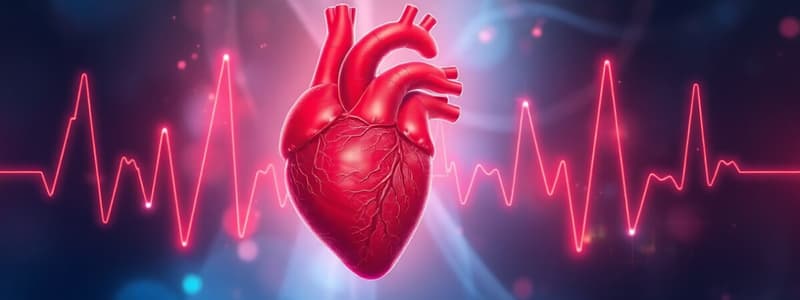Podcast
Questions and Answers
What percentage of the end diastolic volume (EDV) is contributed by passive ventricular filling?
What percentage of the end diastolic volume (EDV) is contributed by passive ventricular filling?
- 25-30%
- 100%
- 70% (correct)
- 50%
What initiates the closure of the semilunar valves during the cardiac cycle?
What initiates the closure of the semilunar valves during the cardiac cycle?
- Flow of blood into the atria
- Reduction in ventricular pressure (correct)
- Increase in atrial pressure
- Contraction of the ventricles
During isovolumetric relaxation, what occurs in the ventricles?
During isovolumetric relaxation, what occurs in the ventricles?
- Ventricles fill with blood
- Ventricles contract to pump blood out
- Ventricles relax while all valves are closed (correct)
- All valves are open
What is the primary cause for the third heart sound (S3) during the cardiac cycle?
What is the primary cause for the third heart sound (S3) during the cardiac cycle?
Which pressure change leads to the closure of the AV valves at the beginning of a new cycle?
Which pressure change leads to the closure of the AV valves at the beginning of a new cycle?
The passive filling of the ventricles accounts for approximately ______% of the end diastolic volume (EDV).
The passive filling of the ventricles accounts for approximately ______% of the end diastolic volume (EDV).
During ventricular diastole, the closure of the semilunar valves is associated with a reduction in ventricular ______.
During ventricular diastole, the closure of the semilunar valves is associated with a reduction in ventricular ______.
The atria contract to provide an additional ______% of the end diastolic volume (EDV).
The atria contract to provide an additional ______% of the end diastolic volume (EDV).
A decrease in atrial pressure during diastole is due to the flow of blood into the ______.
A decrease in atrial pressure during diastole is due to the flow of blood into the ______.
The closure of AV valves occurs when ventricular pressure exceeds ______ pressure.
The closure of AV valves occurs when ventricular pressure exceeds ______ pressure.
Flashcards are hidden until you start studying
Study Notes
Ventricular Diastole
- Ventricular relaxation causes a reduction in ventricular pressure, leading to the closure of the semilunar valves.
- The closure of the semilunar valves contributes to the second heart sound (S2).
- The isovolumetric relaxation phase occurs when all valves are closed, resulting in a constant ventricular volume.
- The end systolic volume (ESV) represents the amount of blood remaining in the ventricles after systole, typically about 50 ml.
- The aortic dicrotic notch coincides with the closure of the aortic valve.
- Continued ventricular relaxation results in a decrease in pressure, allowing the opening of the atrioventricular (AV) valves.
- Passive filling, the initial rapid flow of blood into the ventricles, accounts for approximately 70% of the end diastolic volume (EDV).
- The passive ventricular filling contributes to the third heart sound (S3).
- During ventricular filling, atrial pressure decreases due to the inflow of blood into the ventricles.
Atrial Systole & Diastole
- Atrial diastole continues throughout most of the cardiac cycle, allowing venous return.
- Atrial systole, the contraction of the atria, completes ventricular filling, contributing 25%-30% of the end diastolic volume.
- The end diastolic volume normally reaches approximately 120 ml.
- Atrial pressure rises during atrial systole, causing the "a wave" on the pressure waveform.
- The fourth heart sound (S4) may occur in hypertensive patients due to forceful atrial contraction.
A New Cycle
- As ventricular systole begins, the increasing ventricular pressure exceeds the atrial pressure, leading to the closure of the AV valves.
- The cycle then repeats.
Pressure Volume Curve
- The pressure volume curve is a useful tool for visualizing the changes in ventricular pressure and volume throughout the cardiac cycle.
Cardiac Cycle Events
- The second heart sound (S2) occurs when the semilunar valves close.
- The sound of S2 coincides with the aortic dicrotic notch.
- The dicrotic notch is caused by the rapid closure of the aortic valve.
- During isometric relaxation, all valves are closed.
- End systolic volume (ESV) is the volume of blood remaining in the ventricle after systole.
- ESV is approximately 50 ml.
- 70% of end diastolic volume (EDV) is filled passively.
- The third heart sound (S3) is caused by passive ventricular filling.
- Atrial pressure decreases during ventricular diastole as blood flows into the ventricles.
- Atrial diastole lasts throughout most of the cardiac cycle.
- Atrial diastole is necessary for venous return to the heart.
- Atrial systole completes ventricular filling.
- Atrial systole pumps 25-30% of the end diastolic volume into the ventricles.
- Atrial systole causes an increase in atrial pressure, called the “a” wave.
- The fourth heart sound (S4) may be caused by atrial systole in hypertensive patients.
- The fourth heart sound is normally not audible.
- A new ventricular systole closes the AV valves.
- The entire cardiac cycle repeats.
Pressure Volume Curve
- The pressure volume curve is a graphical representation of the pressure changes in the ventricles during the cardiac cycle.
Studying That Suits You
Use AI to generate personalized quizzes and flashcards to suit your learning preferences.




